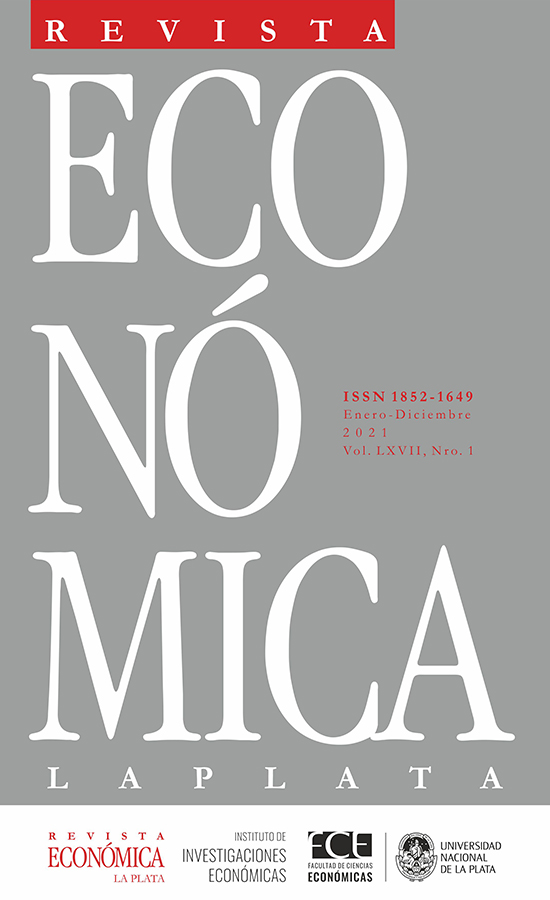Forecasting crop yields through climate variables using mixed frequency data. The case of Argentine soybeans
DOI:
https://doi.org/10.24215/18521649e022Keywords:
yields, forecasting, climate, mixed-frequency, soybeansAbstract
This article evaluates the value of information on climate variables published in advance and at a higher frequency than the target variable of interest -crop yields- in order to get short-term forecasts. Aggregate and disaggregate climate data, alternative weighting schemes and di erent updating schemes are used to evaluate forecasting performance. This study focuses on the case of soybean yields in Argentina. Results show that models including high frequency weather data outperformed particularly during the three consecutive compaigns after 2008/09 when soybean yield decreased almost by 50%. Furthermore, forecast combinations showed a better forecasting performance than individual forecasting models.
Downloads
Metrics
References
Andreou, E., Ghysels, E., & Kourtellos, A. (2013). Should macroeconomic forecasters use daily financial data and how? Journal of Business & Economic Statistics 31(2), 240–251.
Auffhammer, M., V. Ramanathan, & J. R. Vincent (2012). Climate change, the monsoon, and rice yield in India. Climatic Change 111(2), 411–424.
Clark, T. E., & McCracken, M. W. (2010). Averaging forecasts from VARs with uncertain instabilities. Journal of Applied Econometrics 25(1), 5–29.
Ghysels, E., Santa-Clara, P. & Valkanov, R. (2004). The MIDAS touch: Mixed data sampling regression models. University of North Carolina and UCLA Discussion Paper..
Ghysels, E., Santa-Clara, P., & Valkanov, R. (2006). Predicting volatility: getting the most out of return data sampled at different frequencies. Journal of Econometrics 131(1-2), 59–95.
Giacomini, R. & Rossi, B. (2010). Forecast comparisons in unstable environments. Journal of Applied Econometrics 25(4), 595–620.
Hendry, D. F. & Clements, M. P. (2004). Pooling of forecasts. The Econometrics Journal 7(1), 1–31.
Jansen, W. J., Jin, X. & de Winter, J. M. (2016). Forecasting and nowcasting real GDP: comparing statistical models and subjective forecasts. International Journal of Forecasting 32(2), 411–436.
Lobell, D. B. & Burke, M. B. (2009). Climate change and food security: adapting agriculture to a warmer world, Volume 37. Springer Science & Business Media.
Lobell, D. B. & Burke, M. B. (2010). On the use of statistical models to predict crop yield responses to climate change. Agricultural and Forest Meteorology 150, 1443–1452.
Lobell, D. B., Cahill, K. N. & Field, C. B. (2007). Historical effects of temperature and precipitation on California crop yields. Climatic Change 81, 187–203.
Makridakis, S., Spiliotis, E. & Assimakopoulos, V. (2018). The M4 competition: Results, findings, conclusion and way forward. International Journal of Forecasting 34, 802–808.
Marcellino, M. (2002). Forecasting pooling for short time series of macroeconomic variables. Oxford Bulletin of Economics and Statistics 66, 91–112.
Ray, D. K., Gerber, J. S., MacDonald, G. K. & West, P. C. (2015). Climate variation explains a third of global crop yield variability. Nature Communications 6, 5989.
Reilly, J. & Schimmelpfennig, D. (2000). Irreversibility, uncertainty, and learning: portraits of adaptation to long-term climate change. Climatic Change 45(1), 253–278.
Schlenker, W. & Lobell, D. B. (2010). Robust negative impacts of climate change on african agriculture. Environmental Research Letters 5(1), 014010.
Schlenker, W. & Roberts, M. J. (2009). Nonlinear temperature effects indicate severe damages to us crop yields under climate change. Proceedings of the National Academy of Sciences 106(37), 15594–15598.
Tibshirani, R. (1996). Regression shrinkage and selection via the lasso. Journal of the Royal Statistical Society: Series B (Methodological) 58(1), 267–288.
Timmermann, A. (2006). Forecast Combinations. North Holland.
Welch, J. R., Vincent, J. R., Auffhammer, M., Moya, P. F., Dobermann, A., & Dawe, D. (2010). Rice yields in tropical/subtropical Asia exhibit large but opposing sensitivities to minimum and maximum temperatures. Proceedings of the National Academy of Sciences 107(33), 14562–14567.
Wheeler, T. R., Craufurd, P. Q., Ellis, R. H., Porter, J. R., & Prasad, P. V. (2000). Temperature variability and the yield of annual crops. Agriculture, Ecosystems & Environment 82(1-3), 159–167.
Downloads
Published
How to Cite
Issue
Section
License
The material published in the journal is distributed under a Creative Commons Attribution-NonCommercial-NoDerivatives 4.0 International (CC BY-NC-ND 4.0) license. This license requires proper credit to be given, a link to the license to be provided, and changes to be indicated. It does not permit commercial use of the work, and if the work is remixed, transformed, or otherwise modified, distribution of such modification is not allowed.






























